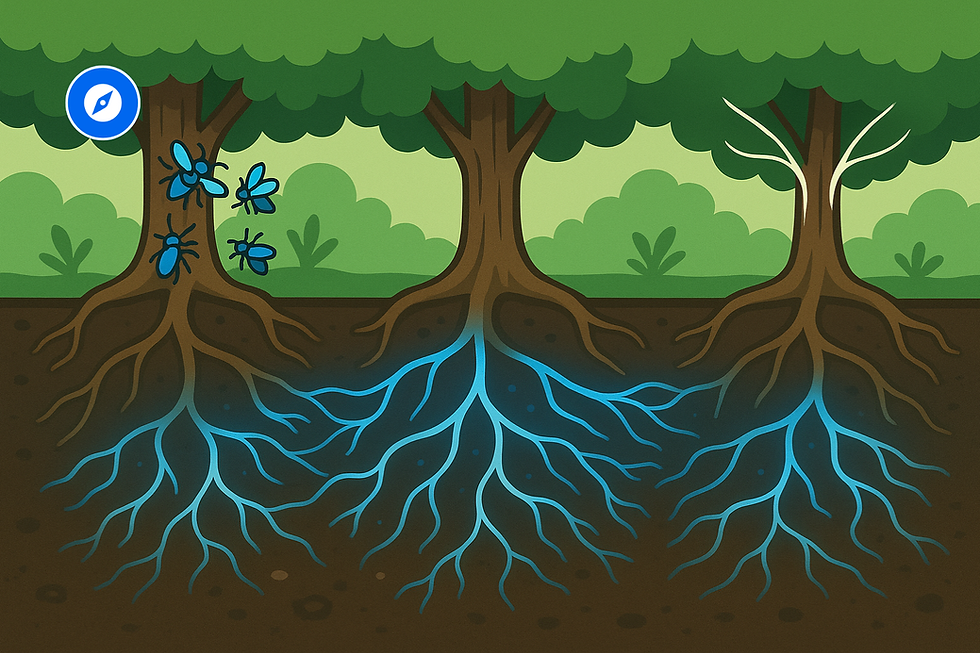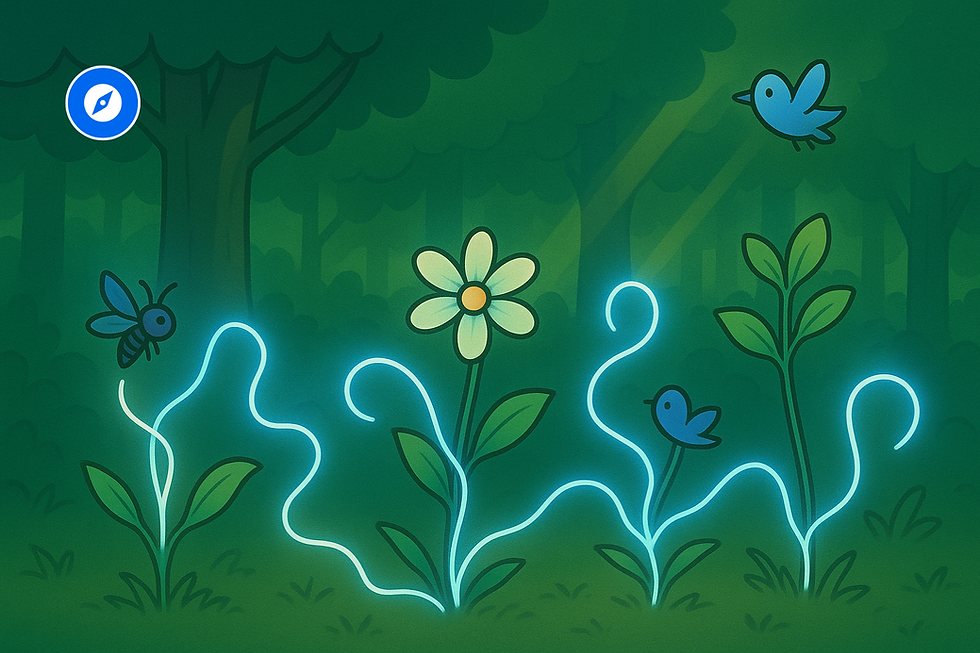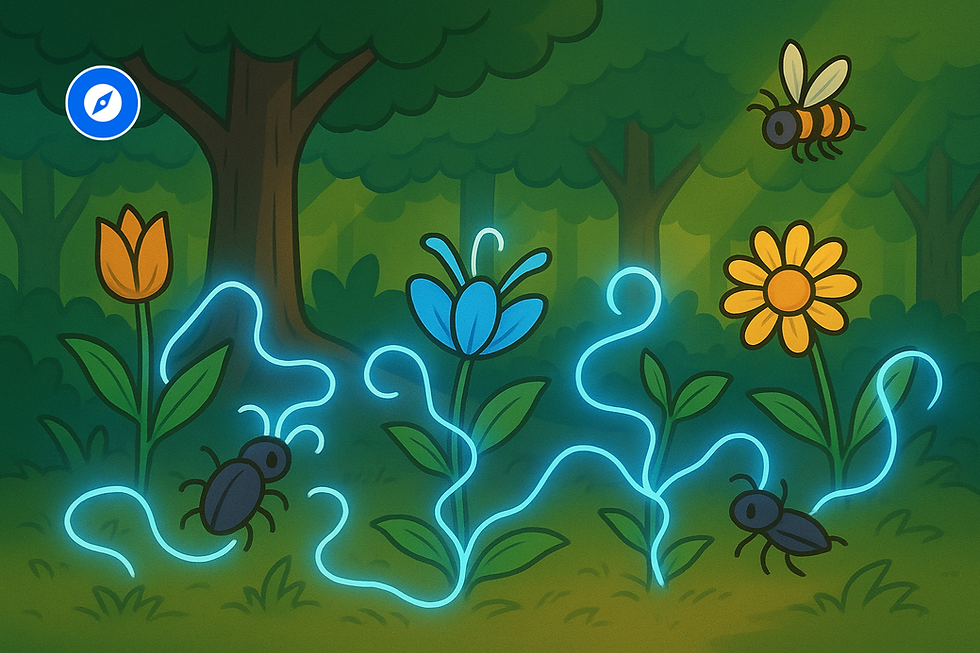How Plants “Talk” to Each Other Underground
- Laura Morini

- Oct 2
- 9 min read
Updated: 5 days ago

Whispers Beneath the Soil
Dr. Helena Voss knelt in the damp forest, notebook in hand, studying the tangle of roots beneath a centuries-old oak. Her assistants, Kiran and Mei, crouched nearby, carefully brushing away soil to reveal the intricate web of roots hidden beneath the surface. Helena had spent years fascinated by the silent communication happening below their feet, the subtle whispers of life unseen.
“Look closely,” she said, pointing at a small cluster of roots. “There is a language here, if we only know how to read it.” Kiran leaned in, eyes wide. “But how can plants talk? They do not have mouths, ears, or brains.” Helena smiled. “Not in the way we understand, but communication is not limited to our senses. Roots release chemicals, signals, and even electrical impulses. Messages travel through the soil, reaching neighbors, warning them, or sharing resources.”
Mei carefully noted the tiny fungi threads linking the roots together. “It almost feels like a network,” she said. Helena nodded. “Exactly. Mycorrhizal fungi create connections that allow trees, shrubs, and even grasses to exchange nutrients and information. It is a hidden society beneath the forest floor, vibrant and dynamic, yet quiet to human ears.”
As they dug a little deeper, tiny roots intertwined with the fungal threads, revealing a delicate balance. Helena reflected aloud, “Every plant here is both sender and receiver, part of a conversation that has been happening long before humans arrived. The soil is alive in a way that challenges how we think about intelligence and cooperation.”
The trio sat silently for a moment, contemplating the rich, unseen network beneath the soil. Helena knew they had only glimpsed the surface of a conversation that spanned centuries, species, and ecosystems, a dialogue that had shaped life on Earth from below.

The Secret Web: Mycorrhizal Fungi Networks
Helena, Kiran, and Mei carefully traced the delicate threads of mycorrhizal fungi that wove through the soil like invisible highways. “These are the secret web of the forest,” Helena explained, her voice filled with wonder. “They connect plants of all sizes, from towering oaks to tiny ferns. Through this network, trees can send nutrients, warnings, and even chemical signals to each other.”
Kiran gently lifted a handful of soil, letting the sun illuminate the fine, branching filaments. “It looks like nothing,” he said, “but it is actually a sophisticated system. How did we not know this earlier?” Helena smiled. “Because much of life’s complexity happens quietly. Humans often miss the subtleties of slow, patient processes. Fungi may seem passive, but they orchestrate one of the most intricate communication systems on Earth.”
Mei observed as a cluster of young saplings appeared to thrive near older trees. “So the older trees are helping the younger ones?” she asked. Helena nodded. “Yes. The fungi facilitate nutrient exchange and even relay chemical warnings when danger approaches. Trees are not isolated; they are socially intelligent in their own way, relying on networks that span meters, sometimes kilometers, underground.”
Helena paused to sketch the patterns of fungal filaments connecting roots, labeling each intersection and branch. “It is humbling,” she said. “We often consider intelligence as a human trait, but here is an intelligence embedded in cooperation and communication, in patience and persistence. The secret web reminds us that life finds ways to collaborate quietly, beneath the surface, unseen yet vital.”
The students sat in awe, realizing the forest was not just a collection of individual trees, but a living community, sustained by invisible threads that spoke in signals older than human memory. Every movement, every pulse, hinted at a language that humans were only beginning to understand.

Warning Signals Through the Earth
Helena guided Kiran and Mei to a grove where a patch of trees had been damaged by insect infestation. She knelt beside a maple, brushing the soil around its roots. “Observe carefully,” she said. “Plants are not passive victims. They can warn one another when danger approaches.”
Mei frowned. “But how does that work? They cannot shout or move.” Helena smiled. “They rely on chemical signals transmitted through the mycorrhizal network. When one tree is attacked by insects, it releases compounds into the soil. The fungi carry these signals to neighboring plants, which then prepare their defenses. Leaves may thicken, toxins increase, or growth patterns shift. It is a quiet alarm system, invisible yet incredibly effective.”
Kiran knelt beside a younger sapling, brushing his fingers over its delicate roots. “It’s like an underground telephone line,” he said. Helena nodded. “Exactly. The forest is constantly exchanging information. When one plant is threatened, others receive the warning and respond preemptively. It is a communal form of intelligence, evolved over millions of years.”
She held up a magnified image of chemical compounds moving through the fungal network. “What fascinates me is that this is both precise and adaptable. Each signal can vary depending on the attacker, the environment, and the recipient plant. There is no central controller, yet the forest behaves as if it were a single organism, reacting to threats in real time.”
As they observed the grove in silence, the students felt the forest’s quiet vigilance. The warning signals beneath the earth were reminders that life communicates in ways beyond human perception, where cooperation and subtlety ensure survival across generations.

Feeding Friends: Trees That Share
Helena led Kiran and Mei to a grove of towering beech and birch trees where sunlight barely touched the forest floor. “Here, the magic of sharing is most apparent,” she said. “Trees are not solitary; they support one another in ways that resemble generosity.”
Mei knelt beside the roots of a young sapling struggling in the shade. “It seems weak. Will it survive?” she asked. Helena smiled. “That sapling is being nourished by its neighbors. Through the fungal network, older, stronger trees send carbohydrates and nutrients to younger or struggling plants. This redistribution strengthens the forest as a whole.”
Kiran picked up a small vial of soil and examined the fine threads of fungi glistening under his flashlight. “So, the fungi act as intermediaries, carrying resources from one tree to another?” Helena nodded. “Exactly. The network functions like a bank of life, facilitating transfers that ensure survival. It is a system of balance, reciprocity, and resilience. Trees that share survive together, and the forest as a community grows stronger.”
She paused to observe a cluster of birches sending nutrients toward a maple sapling. “Sharing is not limited to emergencies,” she explained. “During seasonal changes, trees can redistribute resources, adjusting to drought, shade, or soil deficiencies. The forest demonstrates a quiet wisdom that humans are only beginning to understand.”
Mei looked around, awe in her eyes. “It’s incredible. They are teaching us lessons about cooperation, patience, and interconnectedness without ever speaking.” Helena nodded. “Indeed. Beneath our feet, life has created systems that balance individuality with communal survival, where each contribution echoes through the roots, ensuring the forest thrives as one living entity.”

Messages Beyond the Roots: Plants and Their Allies
Helena guided Kiran and Mei to a sun-dappled clearing where wildflowers and shrubs flourished beside towering oaks. “Plants do not communicate solely with each other,” she explained. “They have allies above and below ground, from insects to fungi, even bacteria. Each participant in the ecosystem receives and sends messages that maintain balance and harmony.”
Kiran observed bees moving among the flowers. “So pollinators are part of this conversation?” he asked. Helena nodded. “Exactly. Flowers release scents and pigments to attract specific insects. These signals are forms of communication, directing allies to perform tasks critical for survival. Meanwhile, underground, the fungal networks carry nutrients and warnings, creating a multidimensional web of interaction.”
Mei crouched beside a patch of mushrooms, noticing tiny insects weaving through the soil. “Even these tiny creatures play a role,” she said. Helena smiled. “Yes. Each element participates in an intricate dialogue. Signals can be chemical, electrical, or visual. Plants send messages through scents, roots, or leaf compounds. Their allies respond, sometimes in ways that humans might not immediately recognize, but the forest thrives because of these exchanges.”
She gestured to a cluster of shrubs responding to the presence of nearby herbivores by releasing compounds that attract predatory insects. “It is a conversation that spans species and kingdoms. No single organism controls it, yet every participant responds to the information, creating a living network that sustains life.”
Kiran and Mei exchanged awed glances. The forest was no longer a simple collection of plants; it was a vibrant, interconnected community. Helena added, “Understanding these alliances teaches us that survival is a cooperative act. Messages flow in every direction, shaping life in ways that humans are only beginning to comprehend.”

Tricks of the Green World: Mimicry and Deception
Helena led Kiran and Mei to a thicket of wild orchids whose petals gleamed in sunlight. “Not all plant communication is cooperative,” she said. “Some plants deceive to survive, using mimicry and trickery as their strategy.”
Mei crouched to observe a flower that closely resembled a female insect. “It looks alive,” she whispered. “The insects are drawn to it and try to mate with the petals.” Helena nodded. “Exactly. This is sexual mimicry. The plant gains pollination without offering nectar. It is a sophisticated form of communication, exploiting the instincts of another species.”
Kiran noticed vines curling around a sapling. “And some plants compete aggressively,” he said. Helena smiled. “Yes. Allelopathy is another trick. Certain plants release chemicals that inhibit the growth of neighbors. Others mimic the scents or colors of different species to avoid herbivory or attract beneficial insects. The forest is full of subtle deceptions, where survival often requires cunning as much as cooperation.”
She pointed to a patch of fungi that appeared harmless on the soil surface. “Even below ground, deception occurs. Some fungi trick plants into forming connections that primarily benefit the fungus, siphoning nutrients while offering little in return. Life beneath the soil is not always fair, but it is adaptive, resourceful, and creative.”
The students marveled at the duality of nature, where collaboration and cunning coexisted. Helena concluded, “Understanding these tricks teaches us that intelligence and strategy are not confined to animals. Plants and fungi have evolved complex behaviors that challenge our assumptions about awareness, intention, and communication in the natural world.”

The Hidden Minds of Plants
Helena gathered Kiran and Mei under a sprawling banyan tree whose aerial roots reached toward the forest floor like silent sentinels. “What we call intelligence is often measured by human standards,” she began, “but plants show remarkable problem-solving abilities and adaptive behaviors that hint at a kind of hidden mind.”
Mei traced the roots of a young fig tree, noting how they bent around rocks and obstacles. “It seems like the roots know where to go,” she said. Helena smiled. “In a sense, they do. Plants sense light, gravity, moisture, and chemical gradients, adjusting their growth patterns to optimize survival. Their ‘decisions’ are not conscious, but they represent a dynamic, responsive system, capable of learning from past interactions.”
Kiran observed a vine navigating its way toward a support tree. “So movement isn’t random?” he asked. Helena shook her head. “Far from it. The vine integrates multiple cues, using an inherent intelligence of adaptation. Even without a brain, plants can solve problems, remember environmental signals, and respond in ways that increase their survival chances.”
Helena dug slightly, revealing a network of roots and fungi intertwined beneath the soil. “Some researchers call this a plant’s ‘cognitive network.’ It is distributed, collective, and incredibly efficient. Trees communicate, share, warn, and adapt. Each interaction contributes to a forest-wide intelligence that humans are only beginning to perceive.”
Mei looked up at the canopy, awed. “It feels alive, like it’s thinking.” Helena nodded. “In a way, it is. The hidden minds of plants teach us that awareness does not require neurons or brains. Life has found countless ways to process information, respond, and thrive. Observing them changes how we understand consciousness and intelligence itself.”

Lessons from the Underground Conversation
Helena, Kiran, and Mei sat on the forest floor, surrounded by towering trees and the quiet hum of life beneath their feet. “The forest has been speaking to us this entire time,” Helena began. “Not with words, but through connections, signals, and responses. The underground conversation teaches lessons that extend far beyond ecology.”
Kiran looked thoughtful. “Like what?” he asked. Helena smiled. “Cooperation, patience, and attentiveness. Trees share resources, warn one another, and adapt collectively. Life thrives not only through competition but also through communication and mutual aid.”
Mei traced the patterns of roots intertwined with fungi. “It’s like a hidden society, with its own rules and intelligence,” she said. Helena nodded. “Yes. And understanding it requires humility. Humans often seek control and dominance, but nature demonstrates that survival often depends on listening, observing, and responding to subtle cues.”
Helena rose and gestured to the canopy above. “Every plant, every root, every fungal thread participates in a dialogue. It is continuous, patient, and remarkably resilient. By studying these conversations, we can rethink how intelligence, communication, and cooperation exist in ways we might never have imagined.”
The students sat in reflective silence, feeling the forest’s quiet wisdom seep in. Helena concluded, “The underground conversation reminds us that life is interwoven. Every organism plays a role, and every signal matters. If we pay attention, we can learn not only about plants but about connection, adaptation, and the hidden marvels that sustain our world.”
About the Author
I am Laura Morini. I love exploring forgotten histories, curious mysteries, and the hidden wonders of our world. Through stories, I hope to spark your imagination and invite you to see the extraordinary in the everyday.
The forest speaks in whispers beneath the soil, sharing wisdom through roots, fungi, and hidden networks. Share your thoughts in the comments, like this post, and join the conversation about nature’s secret dialogues.
Sign up for the CogniVane Newsletter to explore more stories revealing hidden science, philosophical insights, and the wonders that lie just beneath the surface of our world. Discover the extraordinary in the everyday.




Comments